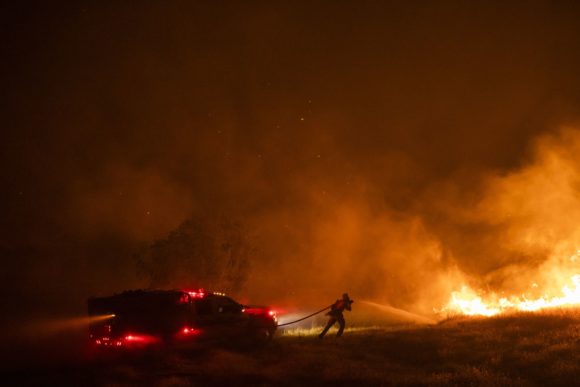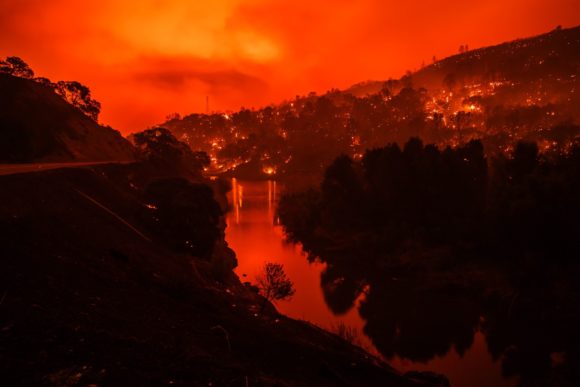Californians are in their sixth month of sheltering in place because of a pandemic that’s killed more than 11,000 residents. Now a new crisis — hundreds of wildfires — is forcing people to prepare to flee their homes at a moment’s notice.
Thousands of residents have had to evacuate as blazes rage in the northern part of the state. In Napa, Sonoma and Solano counties north of San Francisco, a conflagration known as the LNU Lightning Complex has more than doubled in size to at least 124,000 acres, threatening an estimated 25,000 structures.
“This really is unprecedented,” said Bela Matyas, health officer of Solano County, where residents of the town of Vacaville were forced to evacuate as fires crept toward the city. “We need people ideally to be able to stay in their homes and not be socializing with people, not be congregating.
In a state known for its disasters, multiple crises are converging at once. After a summer of soaring coronavirus cases and scaled-back reopenings, Californians have been gripped by record-setting heat that strained its power grid and led to rolling blackouts for the first time since the 2000-2001 energy crisis. Then came wildfires, many of them caused by lightning strikes in the extreme weather.
Beyond the fires burning north of San Francisco, blazes have forced evacuations in Santa Cruz and San Mateo counties to the south. Smoke has blanketed the Bay Area, with San Franciscans finding cars covered in ash and a city that smelled like a camp fire. Near Los Angeles, a fire known as the Lake Fire has burned nearly 26,000 acres since last week.
The state’s largest utility, PG&E Corp., reported almost 20,000 customers without power on Thursday morning, mostly near the fires in Vacaville and in the mountains around Santa Cruz.
While the heat wave that helped lead to the blazes is abating, the fires are now pushing air quality to dangerous levels, with smoke visible from satellites and drifting as far as Nebraska and Arkansas.

By Wednesday afternoon, there were 367 known fires burning in the state, Governor Gavin Newsom said at a press briefing. Of those, 23 were known as complex fires.
“We are experiencing fires the likes of which we haven’t seen in many, many years,” Newsom said.
The state did get some good news over the past few days as it was spared from more of the rolling blackouts, and cooler weather is expected on Thursday. Still, California faces a “risk of resource insufficiency” on Aug. 24, according to a letter to Newsom sent by agencies including the power grid operator.
While heat waves, wildfires and blackouts are nothing new for California, all of that going on during a pandemic is uncharted territory. Huddling fire-evacuees and those looking for relief from the heat and power outages isn’t a great option in the age of Covid-19.
In Solano County — home of the first confirmed U.S. coronavirus infection from community spread — the fires are forcing people out of the home and into evacuation or cooling centers, hotels or with family or friends, Matyas said. That type of congregation is exactly what’s recently pushed California into “substantially elevated rates of Covid,” he said. The state is nearing 640,000 cases of the virus, the most in the U.S.
Not only are the fires forcing people to gather, but the smoke is causing more people to cough, potentially spreading the virus easier. The fact that Covid-19 is a respiratory virus only makes matters worse because smoke may weaken the lungs, Matyas said. He expects places affected by extreme heat, blackouts and wildfire evacuations may very well see increased levels of Covid-19 as a result.
Another troubling sign is that California is early in its wildfire season, which tends to intensify in the fall as dry weather persists and winds pick up. The state has already had 6,754 known fires this year, compared with 4,007 at the same time last year, Newsom said Wednesday.
“This makes me very nervous for our September, October and November,” said Michael Wara, director of the Climate and Energy Policy Program at Stanford University. “What we just experienced in terms of lightning strikes is unprecedented, particularly in August. I don’t know what to make of it.”
The LNU Lightning Complex — caused by lightning strikes — intensified late Wednesday night, spurring evacuations of areas including Travis Air Force Base near Vacaville.
The fire was not far from wine country, a popular place of refuge for many San Francisco residents earlier this year as the pandemic forced everyone indoors, leading people to seek more space. Michael Fanelli, a real estate agent with Sotheby’s in Sonoma County’s Healdsburg, said the period from the beginning of April to the end of June was the busiest he’d ever been in his more than two-decade career. He’s already getting asked by clients about the blazes and is worried by how early the season is starting this year
“Everybody I know has had their insurance jacked up,” he said. “That’s one thing that’s likely to be impacted.”
For San Francisco, the bigger issue is the quality of the air, prompting new pleas from health officials to stay at home.
“We continue to live in unprecedented times and air quality is another challenge that we need to address as a city,” Grant Colfax, San Francisco’s director of health, said during a press conference Wednesday with Mayor London Breed. “We will be living with the intersection of Covid-19, poor air quality and likely heat events for some time.”
–With assistance from Christopher Martin, Noah Buhayar, Mark Chediak, Dana Hull and Brian K. Sullivan.
About the photo (top): A hillside burns near Lake Berryessa during the Hennessey fire in Napa County on Aug. 18.
Was this article valuable?
Here are more articles you may enjoy.


 Musk’s X Probed by UK Over Grok’s Thousands of Sexualized Images
Musk’s X Probed by UK Over Grok’s Thousands of Sexualized Images  What The Return of California’s ‘Death Discount’ Means for Litigation
What The Return of California’s ‘Death Discount’ Means for Litigation  Allianz Built An AI Agent to Train Claims Professionals in Virtual Reality
Allianz Built An AI Agent to Train Claims Professionals in Virtual Reality  California Governor Seeks $200M to Replace EV Tax Credits Cut by Trump
California Governor Seeks $200M to Replace EV Tax Credits Cut by Trump 